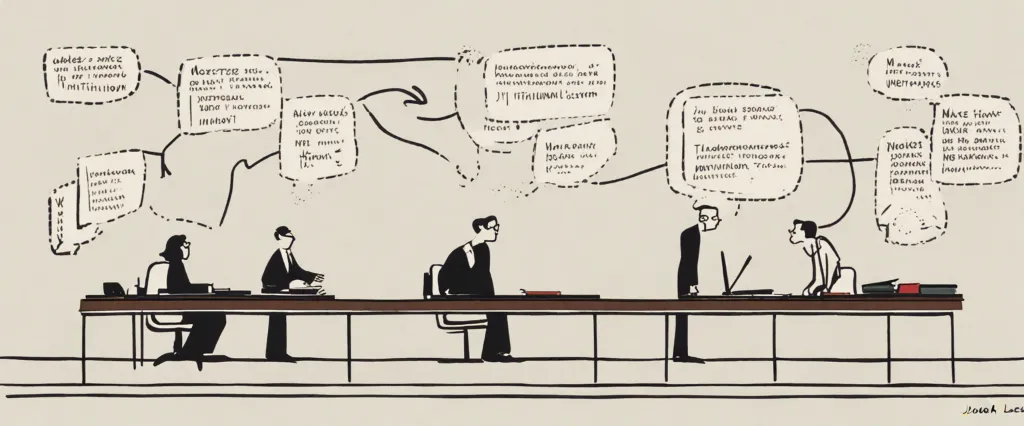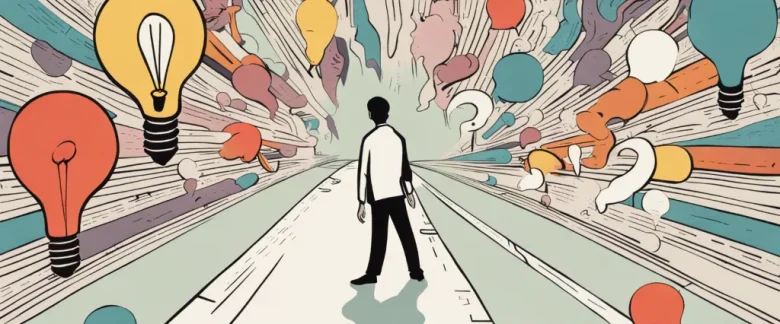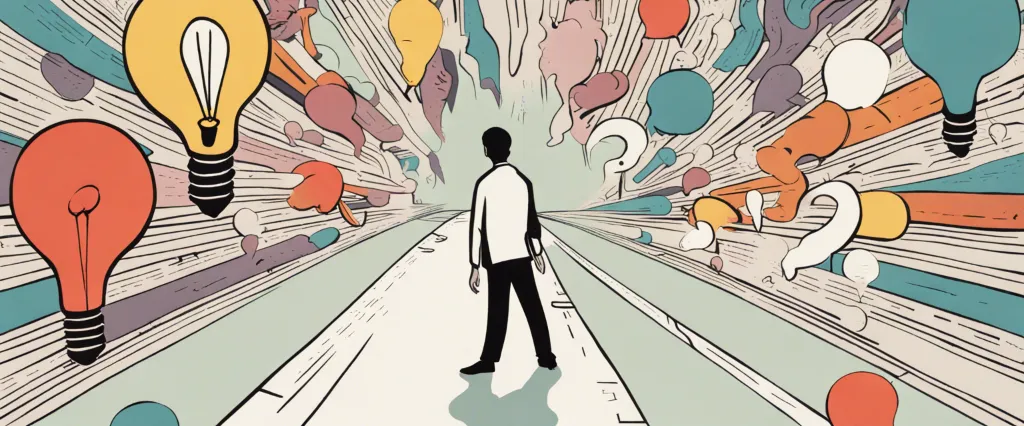In “How We Decide,” Jonah Lehrer delves into the intricate workings of human decision-making. This captivating exploration unravels the complexities of the human brain and sheds light on the often irrational choices we make. Lehrer, a renowned science writer and journalist, is known for his ability to communicate complex scientific concepts in an accessible manner. With a background in neuroscience, Lehrer combines his expertise with engaging storytelling, offering readers insights into the fascinating world of decision science. His book not only delves into the biology and psychology behind decision-making but also exposes the flaws and biases that can hinder our ability to make rational choices. Through captivating anecdotes and compelling research, Lehrer skillfully highlights the profound influence emotions, intuition, and reason have on our decision-making processes.
Chapter 1: The Brain’s Decision-Making Process – Exploring the neuroscience behind decision-making.
In Chapter 1 of “How We Decide” by Jonah Lehrer, the author delves into the neuroscience behind decision-making. Lehrer begins by discussing the story of an experienced firefighter unexpectedly finding himself in a life-or-death situation, where his decision-making process played a critical role in his survival. This anecdote sets the stage for understanding the intricate workings of the brain’s decision-making process.
Lehrer explains that decision-making involves a dance between two key brain regions: the prefrontal cortex and the limbic system. The prefrontal cortex is responsible for rational thinking, weighing pros and cons, and considering long-term consequences, while the limbic system generates emotions and instincts.
He notes that often decisions are influenced more by emotions and gut instincts than by careful reasoning. Lehrer illustrates this with the example of Phineas Gage, a railroad worker who survived an accident that damaged his prefrontal cortex, leading to a change in his decision-making abilities. Without the emotional input originating from the limbic system, decision-making became complex and irrational for Gage.
Additionally, Lehrer explores the concept of emotions as shortcuts in decision-making. He explains how emotional responses can guide us in making quick and efficient choices, especially in situations where time is limited. Emotions, therefore, hold an evolutionary role in helping us make decisions that enhance our chances of survival.
By introducing cutting-edge research and various real-life examples, Lehrer establishes a foundation for further exploration of decision-making processes. The chapter highlights the interconnectedness of rational thinking and emotional responses, and sets the stage for understanding how these elements shape our choices and actions.
Chapter 2: Intuition vs. Analysis – Examining the interplay between intuitive and analytical thinking in decision-making.
Chapter 2 of “How We Decide” by Jonah Lehrer explores the dynamics between intuitive and analytical thinking in the decision-making process. The chapter centers around the question of when to trust our gut instincts and when to rely on deliberate analysis.
Lehrer begins by introducing two contrasting decision-making styles: Type 1 and Type 2 thinking. Type 1 thinking is characterized by quick, intuitive judgments based on past experiences and emotions, while Type 2 thinking involves deliberate, systematic analysis and reasoning. Lehrer argues that both approaches are essential, and the key lies in understanding when to employ each.
The chapter delves into the concept of the adaptive unconscious, which refers to the vast amount of information our brain processes outside our conscious awareness. Lehrer highlights how our intuition draws upon this information, enabling us to make fast and accurate judgments. However, he also warns that our intuition is not infallible and can be influenced by biases and emotions.
Lehrer presents numerous studies and anecdotes that demonstrate the power of intuition. For instance, he discusses the remarkable abilities of expert firefighters and chess masters to make split-second decisions based on patterns they have ingrained through practice and experience.
However, Lehrer also emphasizes the limitations of intuition. He presents stories of decision-making failures caused by overreliance on intuition and proposes that being aware of biases, questioning our initial impressions, and seeking additional information can aid in making more informed choices.
In conclusion, Chapter 2 of “How We Decide” underscores the importance of balancing intuition and analysis in decision-making. Understanding when to trust our gut instincts and when to engage in analytical thinking enables us to make better decisions while taking our cognitive limitations into account.
Chapter 3: Emotions and Decisions – Understanding the role of emotions in shaping our choices.
Chapter 3 of “How We Decide” by Jonah Lehrer focuses on the interplay between emotions and decision-making processes. Lehrer highlights the crucial part emotions play in shaping our choices, challenging the conventional belief that logical thinking is entirely separate from our emotional state.
Lehrer begins by introducing Antonio Damasio’s pivotal research on patients with damaged emotional processing areas in their brains. These patients had difficulty making even simple decisions, despite possessing intact cognitive abilities. This finding counters the prevalent view that decision-making is primarily a logical process. Instead, Lehrer puts forth the notion that emotions serve as indispensable guides, as they integrate past experiences, unconscious biases, and predictions about potential outcomes to lead us to make more informed choices.
The chapter further explores the concept of “somatic markers,” which are emotional signals that help us make decisions by attaching emotional significance to different options. Lehrer presents studies that demonstrate how individuals with enhanced emotional awareness tend to make better decisions. Emotions, such as fear and excitement, can offer valuable information that contributes to more effective reasoning.
Additionally, Lehrer discusses the influence of emotions in the realm of intuition and expertise. Emotionally charged situations can evoke instincts and gut feelings that have been extensively trained and honed through experiences. These rapid, instinctual judgments can offer valuable insights that may be lost in lengthy, rational analysis.
In conclusion, Chapter 3 conveys the vital role that emotions play in shaping our decision-making processes. Rather than being adversaries to logical thinking, emotions serve as helpful guides, integrating past experiences, predictions, and unconscious biases to inform our choices. By understanding and utilizing emotions effectively, individuals can enhance their decision-making abilities.
Chapter 4: The Power of Unconscious Mind – Delving into the influence of the unconscious mind on decision-making.

Chapter 4 of Jonah Lehrer’s book “How We Decide” explores the impact of the unconscious mind on decision-making. Lehrer begins by highlighting the familiar phrase “trust your gut,” suggesting that intuition or instinctual decision-making often yields favorable results. However, Lehrer argues that this is not always the case, and he provides a deeper understanding of the influence of the unconscious mind in such decisions.
The chapter delves into the research of Antonio Damasio, a neurologist who studied patients with damage to the emotional centers of their brains. Damasio discovered that despite their ability to reason logically, these patients struggled to make even the simplest decisions. This finding supports the idea that emotions and gut feelings play an integral role in decision-making.
Lehrer then introduces the concept of “somatic markers,” which are gut feelings that arise as emotional responses to certain stimuli. These markers help guide decision-making by providing instant emotional feedback based on previous experiences. This aspect of decision-making operates on an unconscious level, as the somatic markers are formed through years of experience and observation, allowing the brain to quickly process information and make decisions.
The chapter also explores the role of the unconscious mind in the field of advertising and marketing. It discusses how advertisers tap into the emotional response of consumers to create persuasive campaigns that influence their decision-making processes.
Overall, Chapter 4 emphasizes the profound influence of the unconscious mind on decision-making. It highlights the importance of emotions and gut feelings as invaluable tools in guiding us towards making better choices. By understanding and harnessing the power of the unconscious mind, we can improve our decision-making abilities in various aspects of life.
Chapter 5: The Paradox of Choice – Investigating how an abundance of options can hinder decision-making.
Chapter 5 of “How We Decide” by Jonah Lehrer delves into the concept of the paradox of choice by exploring how an abundance of options can inhibit our decision-making abilities. Lehrer begins by sharing the results of an experiment conducted by Sheena Iyengar, who studied the impact of choice overload on decision-making.
Iyengar set up a tasting booth in a supermarket, offering customers a selection of either 6 or 24 flavors of jam. Surprisingly, while more people were initially attracted to the larger selection, only 3% purchased jam from the extensive variety, compared to 30% of those presented with fewer options. This finding demonstrates that having more choices does not always lead to better decisions.
Lehrer delves further into the reasons why excessive options can hinder decision-making. Firstly, the abundance of choices tends to overwhelm our cognitive capacity. When faced with a variety of options, our brain struggles to process and evaluate each one, leading to decision fatigue.
Additionally, too many options often result in unrealistic expectations and regret. When we have numerous alternatives, we tend to develop high expectations, leading to disappointment even if we make a reasonably good choice. Additionally, the fear of making the wrong decision increases as the number of options escalates, which can lead to anxiety and regret.
Lehrer also discusses the role of emotions in decision-making. Emotions are essential for making wise choices, as they serve as a guide based on our experience and intuition. However, an abundance of choices often leads to emotional confusion, preventing us from relying on our instincts.
In conclusion, the paradox of choice suggests that while options may initially seem desirable, they can actually hinder decision-making. The overwhelming number of choices exhausts our cognitive resources, creates unrealistic expectations, and increases anxiety. Ultimately, understanding how to navigate and limit our choices can lead to more effective decision-making.
Chapter 6: The Neuroscience of Risk – Exploring how the brain evaluates and responds to risks.
Chapter 6 of “How We Decide” by Jonah Lehrer, titled “The Neuroscience of Risk – Exploring how the brain evaluates and responds to risks,” delves into the intricate workings of the brain when it comes to analyzing and responding to risks.
Lehrer begins the chapter by highlighting the case of Phineas Gage, a railway worker who survived a devastating accident in which an iron rod pierced through his skull, damaging his prefrontal cortex. This incident, Lehrer asserts, helped researchers understand how crucial this part of the brain is to decision-making and risk evaluation.
The author delves into the concept of risk aversion and introduces the work of neuroeconomist Paul Glimcher. Glimcher devised an experiment involving monkeys and risk, finding that the neurons in their brains fired differently when the animals were faced with varying levels of risk. These findings were then linked to human behavior, suggesting that human brains also assess risk by calculating expected value.
Lehrer further explores the role of emotions in risk assessment, emphasizing that emotions such as fear can help humans make better decisions. An area of the brain called the amygdala is particularly important in evaluating potential threats and triggering appropriate responses.
The chapter also explores the tendency of people to be influenced by their emotions when making financial decisions. This aspect is referred to as affective forecasting and refers to the ability (often fallible) of individuals to predict how they will feel in the future when faced with various situations.
Lehrer concludes the chapter by discussing the implications of these neuroscience findings on real-world applications. For example, knowing how the brain evaluates risks can aid in creating more effective public health messages or designing safer environments that align with natural human risk perception patterns.
Overall, this chapter provides a fascinating insight into the neuroscience behind risk evaluation, shedding light on how our brains navigate and respond to uncertainties.
Chapter 7: Learning from Mistakes – Understanding the importance of learning from failures and mistakes.
Chapter 7 of “How We Decide” by Jonah Lehrer explores the significance of learning from mistakes and failures. Lehrer emphasizes how mistakes can serve as valuable learning experiences and catalysts for personal growth and success.
The chapter begins by highlighting the fact that humans have a tendency to ignore or suppress failures, instead of embracing them as opportunities for improvement. Lehrer argues that this avoidance of failure hampers our ability to make better decisions because we fail to learn from our past mistakes. He explains that our aversion to failure stems from societal conditioning and fear of judgment, as well as the misconception that success and failure are polar opposites.
Lehrer delves into the psychology and neuroscience behind failure and its impact on decision-making. He explains that when we make mistakes, our brain experiences a surge in the neurotransmitter dopamine, which drives us to analyze our actions and make necessary adjustments. This natural response provides an incentive to learn from our failures and improve future decision-making processes.
The author also emphasizes the importance of maintaining a growth mindset when it comes to failure. Those who embrace failure as an opportunity to learn and grow tend to exhibit higher levels of resilience and creativity, ultimately leading to greater success in decision-making. Lehrer highlights numerous case studies and examples of successful individuals who attribute their achievements to learning from their mistakes.
In conclusion, Chapter 7 of “How We Decide” emphasizes the necessity of understanding and learning from failures and mistakes. By embracing failure as a valuable learning experience, individuals can improve their decision-making processes, foster resilience, and achieve greater success in their personal and professional lives.

Chapter 8: Improving Decision-Making – Discovering strategies to enhance our decision-making skills and make better choices.
Chapter 8 of “How We Decide” by Jonah Lehrer is titled “Improving Decision-Making – Discovering strategies to enhance our decision-making skills and make better choices.” In this chapter, Lehrer explores various techniques and strategies that individuals can employ to improve their decision-making abilities.
Lehrer highlights the significance of intuition in decision-making, explaining that it is often the result of a subconscious mental process known as pattern recognition. However, he warns that intuition is susceptible to biases and errors. The chapter emphasizes the importance of being aware of these biases and employing strategies to overcome them.
One such strategy is to embrace uncertainty and avoid jumping to conclusions too quickly. By questioning our initial assumptions and considering alternative viewpoints, we can overcome confirmation bias and make more informed choices. Lehrer also suggests the technique of “considering the opposite,” which involves actively imagining the opposite outcome or decision and evaluating its merits. This helps to counteract our natural tendency to focus on information that confirms our existing beliefs.
Another strategy Lehrer explores is the concept of “the outside view.” Rather than relying solely on personal experiences and knowledge, individuals can benefit from considering data and information from similar situations faced by others. By broadening our perspective, we can gain valuable insights and avoid falling victim to the shortcomings of personal biases.
Lehrer also highlights the significance of emotional intelligence in decision-making. Emotional regulation and understanding the emotional context of a decision can significantly impact the outcome. The author stresses the importance of self-awareness and recognizing when emotions are clouding judgment.
Overall, Chapter 8 provides readers with practical strategies for enhancing decision-making skills. By recognizing and addressing biases, embracing uncertainty, considering alternative perspectives, and understanding the emotional aspects of decision-making, individuals can make better choices and improve their overall decision-making abilities.
After Reading
In “How We Decide” by Jonah Lehrer, the author explores the complex and fascinating world of decision-making. He delves into the science of the brain and highlights the subtle factors that influence our choices. Lehrer emphasizes that decisions are not purely rational, but often driven by emotions and irrational biases.
Through numerous examples and studies, Lehrer demonstrates how our brains weigh options, process information, and ultimately arrive at a decision. He discusses the power of intuition and the role of emotions in guiding our choices. Additionally, Lehrer examines how neurological disorders, such as damage to the prefrontal cortex, can significantly impact decision-making capabilities.
One of the key takeaways from “How We Decide” is the importance of embracing emotions in the decision-making process. Lehrer argues that suppressing emotions can lead to poor choices, as our feelings often hold valuable insight. By understanding the interplay between reason and emotion, we can make better-informed decisions and improve our overall cognitive abilities.
In conclusion, “How We Decide” offers a thought-provoking exploration of the complexities of decision-making. Lehrer’s engaging narrative and scientific insights provide readers with a deeper understanding of how our brains work and how we can make more effective and rational choices.
1. Thinking, Fast and Slow” by Daniel Kahneman: This book explores the two systems that drive the way we think – the fast, intuitive system and the slow, deliberate system. Kahneman, a Nobel laureate, dives into cognitive biases and decision-making processes, merging psychology and economics in a thought-provoking manner.
2. Blink: The Power of Thinking Without Thinking” by Malcolm Gladwell: In this captivating book, Gladwell delves into the power of our unconscious mind in making split-second decisions. Through fascinating case studies, he explores how our intuition can sometimes be more reliable than conscious reasoning.
3. Nudge: Improving Decisions About Health, Wealth, and Happiness” by Richard H. Thaler and Cass R. Sunstein: Thaler and Sunstein introduce the concept of “nudges,” small changes in the decision-making environment that can significantly impact our choices. This insightful book provides practical strategies and examples on how to make better decisions and overcome cognitive biases.
4. Predictably Irrational: The Hidden Forces That Shape Our Decisions” by Dan Ariely: Ariely, a behavioral economist, examines irrational behavior and decision-making from an entertaining perspective. Through experiments and anecdotes, he challenges traditional economic theories and highlights the irrational factors that often drive our choices.
5. The Paradox of Choice: Why More Is Less” by Barry Schwartz: This book explores the impact of excessive choices on decision-making and happiness. Schwartz argues that while we assume more choices lead to greater satisfaction, an abundance of options often overwhelms and hampers decision-making. He suggests strategies to simplify decision-making and find more fulfillment amidst the modern abundance of choices.
These books delve into various aspects of decision-making, cognitive biases, and the forces that shape our choices. Each offers a unique perspective and valuable insights from the fields of psychology, economics, and behavioral sciences.




